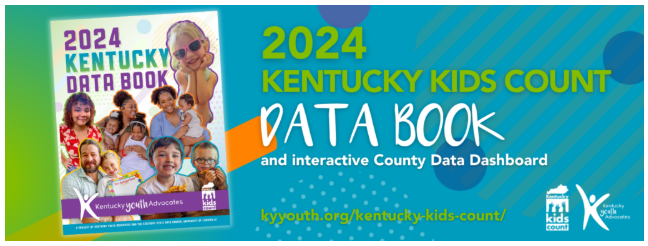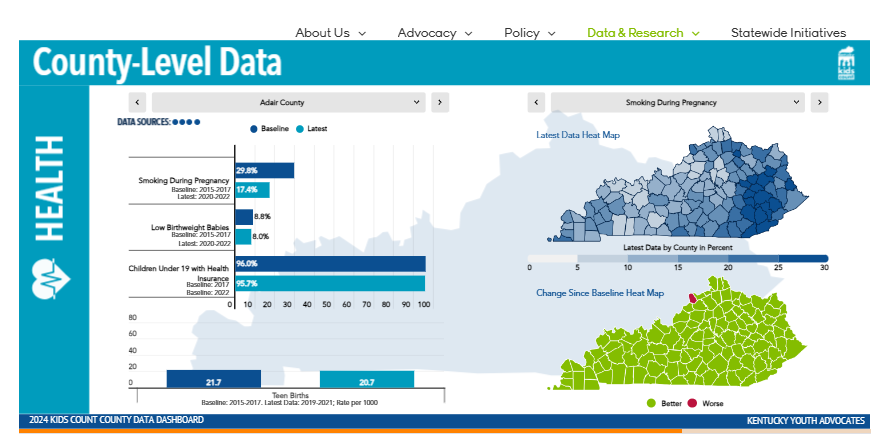2024 Kids Count Kentucky Data Book released with new details about children’s health

By Melissa Patrick
Kentucky Health News
This year’s Kids Count Kentucky Data Book looks at the impact of adverse childhood experiences, focusing on the power of supportive community environments and positive childhood experiences in improving the health of the commonwealth’s children.
“We emphasize each year that what gets measured, gets changed, and this year, I’m urging our policymakers to hear: what can be predicted can be prevented. Understanding ACEs (adverse childhood experiences) and PCEs (positive childhood experiences) creates that opportunity to measure risk and pave the way for prevention,” Terry Brooks, executive director of Kentucky Youth Advocates, said in a news release.
The data book was compiled by KYA and the Kentucky State Data Center at the University of Louisville as part of the 34th annual release of Kids Count, a national initiative of the Annie E. Casey Foundation to track the status of children in the United States.
Adverse childhood experiences, a term used for all types of abuse, neglect and family dysfunction that occur under the age of 18, are common in Kentucky, with one in four of Kentucky’s children having experienced at least two ACEs.
“What we know is while the prevalence of PCEs, or positive childhood experiences, are just not quite as documented or heavily studied, we do know that they are common . . . Stable housing, access to health services and safe family and community environments can set young people up for a lifetime of health, stability and success,” Shannon Moody, KYA’s chief policy and strategy officer said at a press conference to launch the book.
The book offers four key recommendations to ensure every child has access to nurturing environments where they can grow up healthy and safe. They are:
- Safe, affordable housing: Increase the housing supply and quality in Kentucky by investing in affordable and rural housing trust funds and increasing support for programs that help homeowners remove environmental hazards such as lead paint.
- Mentorship: Increase access to mentors for youth and young adults by encouraging schools, community-based organizations, and faith-based institutions to integrate mentoring into their curriculum and programming.
- Health care access: Improve access to care by creating incentives for health care providers who work in underserved communities, accept patients with Medicaid, and co-locate services in places families already are.
- Kinship care: Prioritize relative and fictive kin care placements if a child cannot safely stay in their home of origin and increase the number of supports available to kinship caregivers, including financial assistance, respite support, community-based connection and mentoring.
The data book also provides information about state trends by rating children’s overall well being through 16 indicators in four major categories: economic security, education, family and community and health.
“Overall, Kentucky’s over 1 million children saw improvement in 11 of the 16 child well-being indicators, compared to their baseline data,” according to the release.
Regarding health, the report found that Kentucky saw improvements in the percentage of Kentucky births to women who smoke during pregnancy, to 12.6% in 2020-22, down from 18.7% in 2015-17. The state’s teen birth rate also dropped, to 22.8 births per 1,000 females aged 15-19 in 2019-21, down from 29.7 in 2015-17.
However, the number of low-birthweight babies increased slightly, to 8.9% in 2020-22, up from 8.8% in 2015-17. And the percentage of children with health insurance also saw a slight drop, to 95.8% in 2022, down from 96.3% in 2017.
The county-level data can only be found on the new County Data Dashboard, with county profiles coming soon. KYA provides a webinar on its website to help people learn how to navigate the new dashboard.

“While the Data Book still offers that statewide look at how children and families are faring, the online County Data Dashboard presents data at the county and school district-level in a way that allows users to compare to baseline data, to neighboring counties, and to how the state fares overall,” Brooks said in the release.